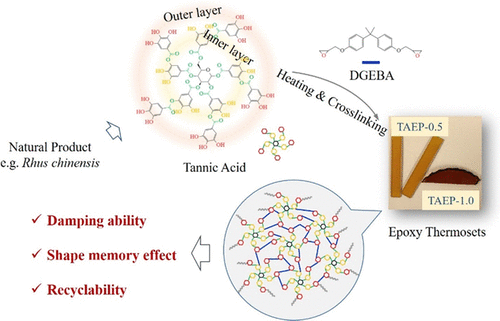当前位置:
X-MOL 学术
›
ACS Sustain. Chem. Eng.
›
论文详情
Our official English website, www.x-mol.net, welcomes your
feedback! (Note: you will need to create a separate account there.)
Biobased Tannic Acid Cross-Linked Epoxy Thermosets with Hierarchical Molecular Structure and Tunable Properties: Damping, Shape Memory, and Recyclability
ACS Sustainable Chemistry & Engineering ( IF 7.1 ) Pub Date : 2019-12-31 , DOI: 10.1021/acssuschemeng.9b05198 Xiaming Feng 1 , Jizhou Fan 1 , Ang Li 1 , Guoqiang Li 1
ACS Sustainable Chemistry & Engineering ( IF 7.1 ) Pub Date : 2019-12-31 , DOI: 10.1021/acssuschemeng.9b05198 Xiaming Feng 1 , Jizhou Fan 1 , Ang Li 1 , Guoqiang Li 1
Affiliation

|
Biomass derivative and recyclability are two major factors in developing sustainable epoxy thermosets that cope with the global oil crisis and climate change. However, the major bottleneck persists in comparatively low strength of biobased epoxy thermosets and a complex synthesis route of recyclable epoxy thermosets. Here, we broke through the bottleneck by simply applying the biomass-based tannic acid as a multifunctional curing agent to a rigid epoxy monomer. Due to the diverse bonding abilities and particular topological structure of the tannic acid, the as-prepared epoxy thermosets exhibited a hierarchical molecular structure with high mechanical strength and tunable functionalities such as damping, shape memory, and recyclability. Specifically, two types of tannic acid cross-linked epoxy thermosets with raw hydroxyl/epoxide ratios of 0.5 and 1.0, respectively, were prepared to investigate the influence of feedstock ratios. When less tannic acid was used, a more complex topological thermoset network and better damping capability were achieved, and the effective damping temperature range was extended to 38.4 °C. On the other hand, the equal-stoichiometric epoxy thermoset possessed a higher tensile strength (∼98.4 MPa), better shape memory ability, and good recyclability. This dual sustainability concept (biomass feedstock and recyclability) may provide a promising opportunity for developing high-performance multifunctional thermoset polymers.
中文翻译:

具有分层分子结构和可调特性的生物基鞣酸交联环氧树脂热固性材料:阻尼,形状记忆和可回收性
生物质衍生物和可循环利用性是开发可应对全球石油危机和气候变化的可持续环氧热固性塑料的两个主要因素。然而,主要瓶颈仍然存在于相对较低的生物基环氧热固性塑料强度和可回收环氧热固性塑料的复杂合成路线中。在这里,我们通过简单地将基于生物质的单宁酸作为多功能固化剂应用于硬质环氧单体,突破了瓶颈。由于单宁酸具有多种键合能力和特定的拓扑结构,因此制备的环氧热固性材料表现出具有高机械强度和可调功能(如阻尼,形状记忆和可回收性)的分层分子结构。具体而言,两种单宁酸交联的环氧热固性树脂,其原始羟基/环氧比为0。分别准备了5和1.0来研究原料比率的影响。当使用较少的单宁酸时,可以获得更复杂的拓扑热固性网络和更好的阻尼能力,并且有效阻尼温度范围扩展到38.4°C。另一方面,等化学计量的环氧热固性树脂具有较高的拉伸强度(约98.4 MPa),更好的形状记忆能力和良好的可回收性。这种双重可持续性概念(生物质原料和可循环利用性)可能为开发高性能多功能热固性聚合物提供有希望的机会。有效阻尼温度范围扩展到38.4°C。另一方面,等化学计量的环氧热固性树脂具有更高的拉伸强度(〜98.4 MPa),更好的形状记忆能力和良好的可回收性。这种双重可持续性概念(生物质原料和可循环利用性)可能为开发高性能多功能热固性聚合物提供有希望的机会。有效阻尼温度范围扩展到38.4°C。另一方面,等化学计量的环氧热固性树脂具有较高的拉伸强度(约98.4 MPa),更好的形状记忆能力和良好的可回收性。这种双重可持续性概念(生物质原料和可循环利用性)可能为开发高性能多功能热固性聚合物提供有希望的机会。
更新日期:2019-12-31
中文翻译:

具有分层分子结构和可调特性的生物基鞣酸交联环氧树脂热固性材料:阻尼,形状记忆和可回收性
生物质衍生物和可循环利用性是开发可应对全球石油危机和气候变化的可持续环氧热固性塑料的两个主要因素。然而,主要瓶颈仍然存在于相对较低的生物基环氧热固性塑料强度和可回收环氧热固性塑料的复杂合成路线中。在这里,我们通过简单地将基于生物质的单宁酸作为多功能固化剂应用于硬质环氧单体,突破了瓶颈。由于单宁酸具有多种键合能力和特定的拓扑结构,因此制备的环氧热固性材料表现出具有高机械强度和可调功能(如阻尼,形状记忆和可回收性)的分层分子结构。具体而言,两种单宁酸交联的环氧热固性树脂,其原始羟基/环氧比为0。分别准备了5和1.0来研究原料比率的影响。当使用较少的单宁酸时,可以获得更复杂的拓扑热固性网络和更好的阻尼能力,并且有效阻尼温度范围扩展到38.4°C。另一方面,等化学计量的环氧热固性树脂具有较高的拉伸强度(约98.4 MPa),更好的形状记忆能力和良好的可回收性。这种双重可持续性概念(生物质原料和可循环利用性)可能为开发高性能多功能热固性聚合物提供有希望的机会。有效阻尼温度范围扩展到38.4°C。另一方面,等化学计量的环氧热固性树脂具有更高的拉伸强度(〜98.4 MPa),更好的形状记忆能力和良好的可回收性。这种双重可持续性概念(生物质原料和可循环利用性)可能为开发高性能多功能热固性聚合物提供有希望的机会。有效阻尼温度范围扩展到38.4°C。另一方面,等化学计量的环氧热固性树脂具有较高的拉伸强度(约98.4 MPa),更好的形状记忆能力和良好的可回收性。这种双重可持续性概念(生物质原料和可循环利用性)可能为开发高性能多功能热固性聚合物提供有希望的机会。















































 京公网安备 11010802027423号
京公网安备 11010802027423号